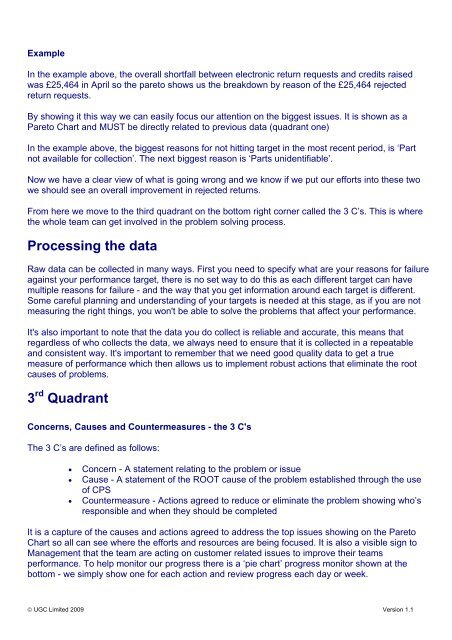The Metric U explained - Unipart Logistics
The Metric U explained - Unipart Logistics
The Metric U explained - Unipart Logistics
Create successful ePaper yourself
Turn your PDF publications into a flip-book with our unique Google optimized e-Paper software.
ExampleIn the example above, the overall shortfall between electronic return requests and credits raisedwas £25,464 in April so the pareto shows us the breakdown by reason of the £25,464 rejectedreturn requests.By showing it this way we can easily focus our attention on the biggest issues. It is shown as aPareto Chart and MUST be directly related to previous data (quadrant one)In the example above, the biggest reasons for not hitting target in the most recent period, is ‘Partnot available for collection’. <strong>The</strong> next biggest reason is ‘Parts unidentifiable’.Now we have a clear view of what is going wrong and we know if we put our efforts into these twowe should see an overall improvement in rejected returns.From here we move to the third quadrant on the bottom right corner called the 3 C’s. This is wherethe whole team can get involved in the problem solving process.Processing the dataRaw data can be collected in many ways. First you need to specify what are your reasons for failureagainst your performance target, there is no set way to do this as each different target can havemultiple reasons for failure - and the way that you get information around each target is different.Some careful planning and understanding of your targets is needed at this stage, as if you are notmeasuring the right things, you won't be able to solve the problems that affect your performance.It's also important to note that the data you do collect is reliable and accurate, this means thatregardless of who collects the data, we always need to ensure that it is collected in a repeatableand consistent way. It's important to remember that we need good quality data to get a truemeasure of performance which then allows us to implement robust actions that eliminate the rootcauses of problems.3 rd QuadrantConcerns, Causes and Countermeasures - the 3 C's<strong>The</strong> 3 C’s are defined as follows:• Concern - A statement relating to the problem or issue• Cause - A statement of the ROOT cause of the problem established through the useof CPS• Countermeasure - Actions agreed to reduce or eliminate the problem showing who’sresponsible and when they should be completedIt is a capture of the causes and actions agreed to address the top issues showing on the ParetoChart so all can see where the efforts and resources are being focused. It is also a visible sign toManagement that the team are acting on customer related issues to improve their teamsperformance. To help monitor our progress there is a ‘pie chart’ progress monitor shown at thebottom - we simply show one for each action and review progress each day or week.© UGC Limited 2009 Version 1.1
















